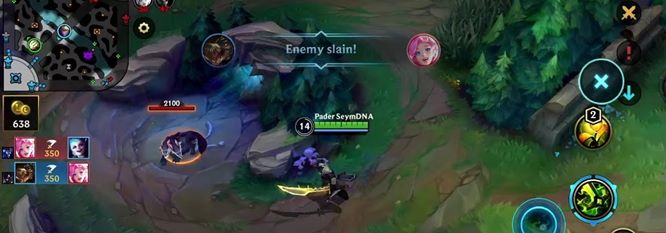Steps to download LOL: Wild Rift PC on LDPlayer Emulator
| 1. Download the emulator LD PLAYER | 4. Search LOL: Wild Rift |
| 2. Install & Open the emulator | 5. Open game LOL: Wild Rift PC |
| 3. Open & sign in to Google Play | 6. Start play LOL: Wild Rift |
League of Legends: Wild Rift is a multiplayer online battle arena (MOBA) game developed and published by Riot Games. It’s free to play title that can be downloaded at the League of Legends website. It is free to play on PC/ Windows.
What is League of Legends: Wild Rift PC?
League of Legends: Wild Rift (LOL WR) is a free-to-play Multiplayer Online Battle Arena (MOBA) game developed by Riot Games. League of Legends features gameplay similar to popular DOTA, in which the player controls a hero with unique abilities and battles it out with enemy players and AI-controlled minions.

Join us as we walk you through everything you need to know about playing League of Legends on your PC.
By reading this guide, you will learn how to download League of Legends, install League of Legends, start playing League of Legends, and much more!
League Of Legends: Wild Rift Plot:
The game has five continuous lane phases, and each player chooses a champion to play during each phase (up to 18 in total) that possesses unique abilities. During all phases, players combat AI-controlled minion waves alongside other players, returning to the lane after reaching their destination unless an enemy-controlled unit or structure intercepts them.
In order to obtain gold, which is used to purchase items that enhance their champion’s abilities and attributes, players must battle neutral monsters that spawn periodically in specially marked areas on the map called “camps”. League Of Legends: Wild Rift can be played in a variety of different game modes, but these are classified into two categories: normal games and ranked games. In both normal and ranked games, teams work together to achieve a victory condition, either destroying an enemy base or razing enough structures to gain control of the battlefield.
Players receive a small amount of gold over time while playing the game through orbs which passively generate gold over time or are acquired when one’s character kills another unit. This is used for buying items during the game that will give boosts in various stats that increase damage dealt/damage received, health points, mana points, energy recharge rate, and many more.
There are four categories of items: weapons, abilities, armor, and magic resistance, with the ultimate item in each category plus other powerful items that grant very big stat bonuses such as Bloodthirster (the best weapon) and Rabadon’s Deathcap (the best ability power amplification item).
The gameplay of LOL Wild rift
League Of Legends: Wild Rift is a session-based game. The goal is to destroy the opposing team’s Nexus. To accomplish a win, the players must work together to achieve through various maps and characters; collaboration between different roles is required for success. League Of Legends: Wild Rift can be played in 25 different maps (referred to as “Fields of Justice”), each one featuring a different terrain or scenario and a different selection of champions.

Players can switch between different champions during the course of a game. If a champion is defeated, players must choose another and continue playing until they lose their “Summoner” or it dies. A match is won when one side destroys the opposing team’s Nexus or if they surrender, similar to chess, where matches may also end in a draw.
League Of Legends: Wild Rift features several game modes for players who wish to focus on certain aspects such as long-term strategy (such as killing neutral monsters), large battles featuring numerous fighters on each side (20v20 fights), or short-term action with three characters chosen per side (3v3).
As in all MOBAs:
League Of Legends: Wild Rift requires teams to play against each other in a series of small arenas called “Fields of Justice”, each with its own terrain, win condition, and selection of a premade group of 10 or 11 characters.
League Of Legends: Wild Rift has a variety of maps designed for two teams of five players. Each map requires defeating computer-controlled enemies in a certain fashion to win the game, such as by destroying an object in the enemy base (a core), killing all opponents, or defending against waves on incoming enemies until time runs out.
League features three main maps: Summoner’s Rift, Twisted Treeline and Howling Abyss. There is also The Crystal Scar (Summoner’s Rift variant) and Proving Grounds (Twisted Treeline variant). A fourth map was planned but later canceled due to community disapproval: the “Magma Chamber.”
Parts of a champion:
Champions have a variety of unique abilities and battle strategies, and each is classified as one of several roles: melee carry (also called assassin), tank, caster (used to designate a magic-damage dealer), support, and jungle. Champions begin every match at a low level with less gold than other champions, but they gain experience over the course of the game.
When slain, combatants respawn in their base after enough time passes and rejoin the fight. The rate at which they respawn depends on the type and number of items equipped; items can be purchased from non-player characters that are present near the spawn points for this purpose. There are three continuous ‘lanes’ that connect each team’s base on the map.
Each lane has several turrets that serve as way-points that must be captured to gain access to the next corresponding set of enemies until reaching the enemy base. Proximity to a turret is important because it will attack nearby enemies. Players can destroy an enemy turret at any time, but they are often protected by weak computer-controlled ‘minions’ that must be cleared before it can be attacked.
League Of Legends: Wild Rift encourages aggressive play – players are placed on opposing teams along with four other teammates and assigned one of three modes: Summoner’s Rift (five-versus-five player versus environment), Twisted Treeline (three-versus-three versus player), or Howling Abyss (single-player versus player with a five-minute timer). In all modes, the goal is to destroy the heart of the enemy base, which is protected by defensive structures and guarded by computer-controlled units.
In “League Of Legends: Wild Rift,” players assume the role of an unseen “summoner” that controls a “champion” with unique abilities and battle strategies in each match. There are over 120 different champions from which to choose, each with its own set of unique attributes and special abilities. Players earn this title by completing structured PVP matches and improve as they compete against higher-level opponents in greater difficulties.
As in most MMORPGs:
There are also several options available for league play, including ranked, customs, and a variety of new game modes.
“League Of Legends: Wild Rift” is free-to-play and all in-game purchases with a material effect on the player’s experience are purely cosmetic. Riot Games, the developers of League Of Legends: Wild Rift, fund their development entirely through microtransactions on these cosmetic items and revenue from smaller-scale competitions known as “Riot”-sanctioned tournaments.
Summoning:
Summoner Spells can be used to aid players or harm opponents according to their type, which falls into four categories: Offensive, Defensive, Support, and Other. Every spell has a certain scale based on champion level and some scale with AP (Ability Power) or AD (Attack Damage). Summoner’s Rift includes a shop near each spawn, featuring items to augment a champion’s abilities or powers.
The most powerful items in the game must be earned through gameplay and cannot be purchased from shops. These include powerful relics that improve champions’ abilities in a variety of ways, usable only by a small number of champions.
Towers:
Towers deal heavy damage to enemy units, but they are “defenseless” against enemy Champions unless an allied Champion is nearby. In order to attack an enemy unit within range, the player must click on that unit.
A targeting reticule will appear over the champion when you have a vision of them, indicating that they can be attacked from your current location; there isn’t another object between the champion and the player’s location.
If there is another object between your champion and the target, you will not be able to attack units in that direction until such time as there are no such objects. Each turret has a limited amount of “health”, which decreases when attacked by enemies or means of AoE (Area of Effect) spells and attacks from enemy Champions.
Champions:
Each League Of Legends: Wild Rift match features two teams made up of five players each, with each team occupying and defending their own “base” on the map. Each team begins at opposite sides of the map in what is known as Summoner’s Rift, near what would be their “Nexus” on classic maps.
Three paths – or ‘lanes’ – connect the bases, running through jungle areas filled with neutral monsters that both sides can fight to earn gold and experience. As in classic MOBAs, defeating computer-controlled monsters earns each character experience; once they earn enough, their level will increase, and the player may choose to upgrade one of his abilities.
There are also special ‘Monster’ minions located in what is called “The Jungle” on either side of the map, which occasionally spawns alone for each team where they proceed down their assigned lanes attacking any enemy units or structures they find.
Each League Of Legends: Wild Rift match takes place under a time limit as an attempt by Riot Games to avoid matches becoming drawn-out affairs conducive only to organized teams able to “farm” large numbers of their own minions for in-game gold, thus providing them a large enough advantage overall to be able to overpower the opposing side even if they did not necessarily have superior individual skill levels.
As a result, there is a time limit on how long a player can leave their champion idle before they are forced into the game, with any players remaining absent when the gates open, leaving their champion behind to fend for themselves against both friends and foe alike.
In order to prevent an entire team from being “farmed” without opposition should all its members suffer from connection issues, League Of Legends: Wild Rift also features an automatic 50% reduction in revealed enemy strength while multiple allied Champions remain disconnected from the match or each other.
The design of League Of Legends: Wild Rift maps places importance on strategic objectives and tactical pacing. Players gain gold and experience by killing the monsters in each map, plus a bonus for defeating an entire wave of minions (known as “last-hitting”) and another bonus when they destroy an enemy tower.
Players can purchase items at shops located at regular intervals along each lane to gain combat bonuses and enhance their abilities. Every match begins with all champions who begin play at level one, but as they participate in games, they earn points to spend on customizing their abilities, statistics, and equipment, though like any similar game mode finding the right balance between cost and benefit is key to ensuring victory.

Unlike other MOBA games, League Of Legends: Wild Rift requires players to choose a single champion to play; once that choice has been made, no other champion can be selected by that player for the duration of the match.
The three lanes are inhabited by enemy minions and several “minor” neutral hostile creatures, which provide a constant source of experience and gold to players who can engage them in combat, which can be increased further with champion abilities.
These monsters grant special player buffs on death, such as “Jungle”, which increases damage done to monsters or minions in that lane until you leave the corresponding section of the map (either by leaving your lane or being defeated).
Destroying an enemy tower allows one team member to advance forward and attack the base directly while their opponents must fight to halt this progression before it is able to destroy their Nexus.
Special units are known as “turrets” are powerful defensive structures that defend each team’s lane and grant gold to whoever hits them – but must be defended by friendly Champions should they come under attack. The game ends when either the enemy Nexus is destroyed or if a team manages to push its way into the other team’s base, then destroy their own Nexus, earning that side victory.
Review the graphics of the game League Of Legends: Wild Rift
League Of Legends: Wild Rift is a fantasy MOBA game. Reviewers have noticed its well-made graphics, which are simply top-notch.
While League Of Legends: Wild Rift isn’t the first free MOBA game, it certainly turns heads with its high-quality 3D graphics that make other games like DoTA 2 look like they’re in need of an upgrade (read more on how to play LoL mobile). One thing about League Of Legends: Wild Rift’s graphics is that it’s stylish and has a very clean interface, yet doesn’t stray away from the epic feel that players love their MOBA games for.
When it comes down to gameplay, League Of Legends (LoL) truly shines above all other MOBAS – without sacrificing performance or quality. Graphics can be a major point in any game, but what really makes a difference is the fluidity of how it’s displayed. League Of Legends: Wild Rift provides great quality with extremely smooth graphics that make gameplay feel natural and intuitive.
Many of League Of Legends: Wild Rift’s spells are more action-orientated, meaning that the player really feels like they’re participating in a fight instead of just controlling it.



